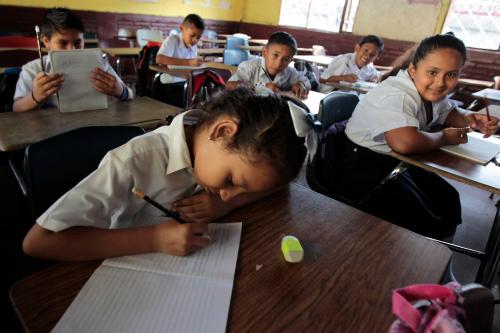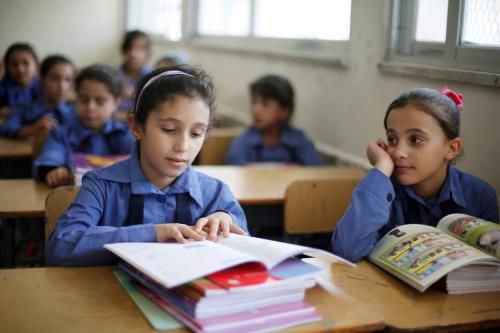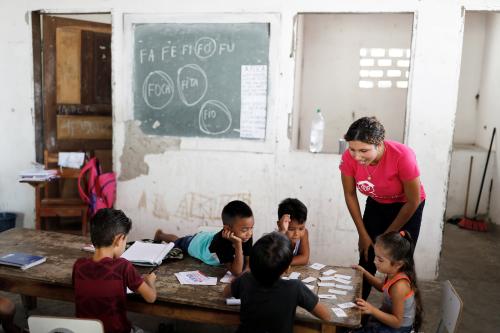This is the third post in a series about using data from 21st century skills assessments.
We are teaching students who will eventually work, use technologies, and solve problems yet unknown. How do we identify the skills that will help prepare them for the challenges of tomorrow’s complex communities and workplaces?
Traditional methods of assessing students’ core skills have dominated education for past decades in Mongolia. That is, assessment has been used mainly for monitoring and accountability. Mongolian schools have primarily assessed the abilities that students acquire at the end of an academic semester as a summative type of assessment. However, as discussed in a recent Brookings report, we have realized that this approach is insufficient. We are striving to change assessment of students’ abilities, not just in core academic domains such as numeracy and literacy, but also in skills required for the 21st century.
At Shine Ue School in Ulaanbaatar, we have experimented with approaches to assess student skills over the past two years, consistent with our identity as an International Baccalaureate (IB) candidate school.
The IB diploma program aims to instill ten attributes in students that are vital to 21st century citizens. These focus on student-centered themes such as communicating, risk-taking, open-mindedness, and reflectivity. To assess the 21st century skills central to these themes, our school renovated the entire curricula. Consequently, activities included in each subject are specifically designed to develop students’ skills and encourage personal development. For instance, the effective use of a presentation in classroom discussions encourages students to become critical thinkers with collaboration skills.
We use both formative and summative assessments to improve student learning. First and foremost, at the beginning of an academic year, students receive a table with descriptions of ten skills to perform self-evaluations. After evaluations have been completed, teachers review the results and undertake an extensive analysis to ascertain what specific skills to target during the coming semester. As a part of the formative approach to assessment, students are asked to reflect on the skills they have improved during each unit. They are also required to demonstrate achievement of the target skill. Afterward, teachers read each student’s reflection and re-evaluate which skills need further attention. Through this process, we encourage our students’ critical thinking skills.
Second, as a summative assessment for English speaking classes, we promote our students’ collaboration skills by engaging them in peer assessments during oral presentations. For this method to work effectively, students receive specific guidelines with a rubric for evaluating each other. Criteria include content, grammatical accuracy, fluency, eye contact, pronunciation, and prosody. After the peer-assessments are done, both teachers and fellow students provide constructive feedback to the students who have given their oral presentation. Following this process, teachers again review and report on whether the students are making actual progress on acquiring collaboration skills. This report is essential to planning the next steps in curriculum and instruction.
Although we are trying to contribute to the development of data collection for instructional systems in Mongolia, we constantly face complexities and challenges. These challenges include the lack of: nation-wide policies enforcing reliable implementation of instructional systems; efficient teacher training workshops to enhance instructors’ knowledge of data-driven assessment and 21st century skills; and sufficient funding to support teachers. In addition, on a national level, some schools are confronted with challenges from both parents and students. There is a tendency among conservative parents, who may be unfamiliar with the concept of students’ holistic development, to focus only on children’s test scores. Furthermore, assessments that involve subjective judgement pose measurement challenges—some students may be inaccurate in their self-reflection and be subjective when evaluating each other. Fortunately, these challenges are on the decline, thanks to new assessment methods and ceaseless efforts by experts around the world.
If Mongolian educational institutions continue to walk on the path of enlightenment and progress, we will see Mongolian children become 21st century citizens ready for the global stage.
The Brookings Institution is committed to quality, independence, and impact.
We are supported by a diverse array of funders. In line with our values and policies, each Brookings publication represents the sole views of its author(s).








Commentary
Using assessment data to help students thrive: Classroom perspectives from Mongolia
December 20, 2018